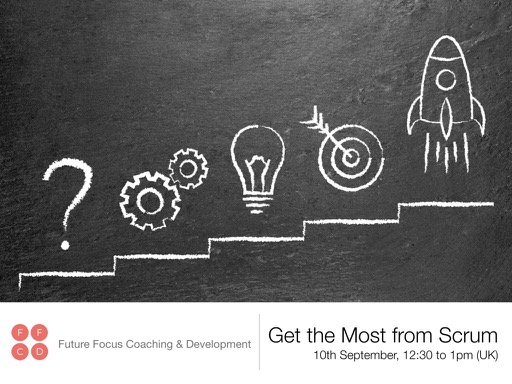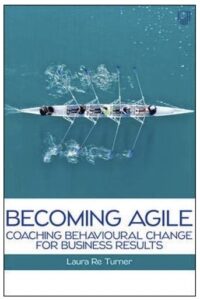
Transcript of Get the Most from Scrum, from the Free Webinar Series to Create an Agile Organisation, on 10th September 2019. Presented by Laura Re Turner, Director, Future Focus Coaching.

Good afternoon everyone. Thank you very much for joining us. I’m the Director of Future Focus Coaching, Laura Re Turner. Welcome to our webinar series on creating an agile organisation. This webinar Get the Most from Scrum, will help you think about the value of using the Scrum Framework and what it takes to get the most value out of using Scrum.
Welcome
Today’s webinar will be for 30 minutes and the presentation part of the webinar will be 15 minutes, followed by 15 minutes of Q&A. The webinar finishes at 1:00 PM and it’s being recorded. The recording will be available on our website this afternoon at http://box5252.temp.domains/~futurhu6/webinar-series-recordings/. I also want to let you know that this webinar is part of a series. We held our first webinar ‘Is Agile Right for our Organisation?’ on the 20th of August, just a few weeks ago almost. People were on their summer holidays. It was great to have such a fantastic turnout for that. Today is the second in the series.
So if you joined us for the first webinar, you’ll know that I like to start with a definition. It’s good to level set and understand what we mean when we talk about Scrum. What better way to find out what Scrum is, than by getting a definition from the Scrum Guide.
“Scrum is not a process, technique, or definitive method. Rather it’s a framework within which you can employ various processes and techniques. Scrum makes clear the relative efficacy of your product management and work techniques so that you can continuously improve the product, the team, and the working environment.”
The Scrum Guide, scrumguides.org
So interestingly, scrum is saying that any processes, techniques, and tools and other methods that you feel you need to use in order to be effective at delivering a product or a project are ok.
Reasons organisations use Scrum
So Scrum Alliance does a survey every year. In the most recent State of Scrum survey from Scrum Alliance, respondents to the survey said that the top three reasons for adopting Scrum were to deliver value to the customer, flexibility and responsiveness, and quality.
Feedback loops of Scrum
What attributes of the Scrum framework give us these features to deliver value to the customer and flexibility and quality? These are achieved when we use the feedback loops of the Scrum framework. [Feedback loops have their origins in systems thinking and you may be interested in our Systemic Agile Coaching course.] Scrum’s meetings are used for examining feedback on what the team has just completed in the previous few weeks, and deciding what to do for the next few weeks.
For example, a planning meeting uses feedback from the previous Sprints to decide what should be delivered in the next Sprint, which is typically two to four weeks. If you say you’re using Scrum and you’re not asking for feedback and using it for forward planning, you’re not using Scrum as it was intended, and you won’t get the benefits organisations expect from Agile.
Do your Sprint Reviews
To get the most value from Scrum, you really need to do your Sprint Reviews. The team must have a Sprint Review with business stakeholders, not just a Product Owner.
This helps the team adapt the product requirements to get the work done in priority order. It helps business stakeholders understand what the team’s working on, and it builds trust and helps the team shift focus when at the end of a Sprint, which is a few weeks long, they find out that the business priorities have changed and they need to do something slightly different.
Do your Sprint Retrospectives
Also to get the most value out of Scrum, do your Sprint Retrospectives. These can be a little bit uncomfortable because in a Retrospective the team talks about which processes, techniques, and interactions among the team members are working or not. This is really where you’re starting to get the most value out of the Scrum framework and where the hard work is done. This helps the team adapt its processes, behaviours and mindset to be more effective.
I’d like to offer you a quote from a certified Scrum Master from State of Scrum Report.
“Scrum is not difficult to implement. The discipline, commitments and capabilities required to be good at delivering real value frequently, and often are hard to master. It takes a lot of work. Teams and organisations suffer from technical and cultural debt. The difficulty is not really scrum; it’s the technical and cultural debt. In these cases, scrum is doing one of the things that it’s great at- making a team’s problems transparent.”
Tiago Garcez, Scrum Coach and Trainer, CST, CSP, CSM, CSPO, REP
Q&A
So I’m interested in what some of the questions are that you have, some of the things that have been working well or not. Please use the Q&A window to submit your questions. How long you’ve been using Scrum? What are some of the challenges you’ve run into? What’s happening in your Sprint Retrospectives? Do business stakeholders attend, and what kind of feedback are you getting from them? Are you doing your Sprint Reviews with your stakeholders? Are you doing your Retrospectives with the team?
Thank you for your questions.
You’ve been using Scrum for four years and as you say, the biggest challenge is building trust with customers. The real challenge is bringing them on the journey with us so that they can start to see that the iterations and the work that we’re doing is really leading to something that’s valuable. To do that, they need to be committed too, and they need to join us for all of the Sprint Reviews.
It’s difficult in a distributed environment when the Product Owner is not the real customer. One of the challenges that we’re finding often is that the Product Owner who is meant to be a representative of the business requirements and the voice of the customer is not a real representative. That the person is perhaps appointed or reluctantly asked to be the Product Owner to the team when the person perhaps doesn’t have the experience to understand what the customer really needs and how to get the requirements or perhaps the authority to make decisions about the priority of the requirements.
Another participant on the webinar said that what he’s done is really to get feedback from people using their product, which is a mobile app, who may be difficult to reach, difficult to get involved in product development. So a Product Owner has to be creative and be a little bit innovative and think about how best to represent the actual users of the app.
Another comment from you is about working iteratively and finding out what the customers, the end users, really need. The temptation is, when planning a big project, to want to start to feel some certainty and get some plans written down and understand what we’re going to be delivering for the next 6 or 12 months. One of the biggest mindset shifts that we make when working in an Agile way is understanding how to use iterations of the product to find out from our end users what they really need next. To do that, we need to suspend the temptation to plan months of work in a project, to try to have certainty.
How Can We Help?
Thank you so much for your questions. It’s been great having you today. I wanted to let you know about some of the work that we do at Future Focus Coaching and Development. We work mainly in two areas:
Business agility
Think about how often you’re asked to do more with less, deliver faster, or create the next killer app to deliver more.
• You need to prioritise your work and deliver product versions incrementally.
• Enable the right people to work together regardless of where they physically sit in the
organisation.
• Develop strategic thinking and plan by business outcomes instead of tasks.
• Learn how to influence your colleagues, customers, suppliers, and business partners to come with you on the journey.
So for this, we work with leaders in order to develop an agile mind-set and behaviours.
Motivated teams
The sparkle of passion and team members comes from giving more responsibility to help the business achieve its strategic goals. Product development teams are most effective when they’re part of the planning process, and they can generate options and shape solutions to problems. Build knowledge sharing networks that can identify end-user’s true needs and possible solutions faster than the hub and spoke management style fostered by command and control management of single individuals.




